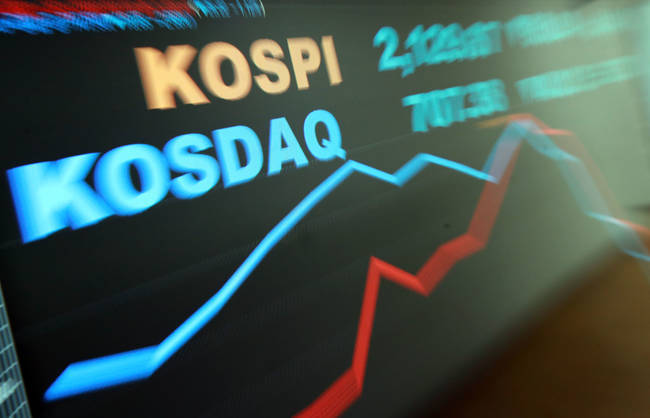South Korean companies listed on the main bourse saw their average debt-to-equity ratio up by nearly 6 percentage-points in the first quarter of the year, data showed Monday, with analysts citing poor corporate performance and implementation of new accounting standards.
The average D/E ratio of 640 Kospi-listed firms, that end their fiscal year in December, increased 6.37 percentage points from the end of the year to 110.7 percent by end-March, according to data provided by the Korea Exchange, the nation’s main bourse operator.
 |
(Yonhap) |
Overall, a total of 756 Kospi-listed firms close their books in December, but the KRX excluded financial firms or those deemed “unqualified” by external auditors.
The D/E ratio provides insight into a company’s use of debt. Usually, a firm with a high ratio is viewed as a higher risk to lenders and investors because it indicates that it has financed a larger amount of its growth through borrowing.
The companies’ debt totaled 1,358.15 trillion won ($1.14 trillion) in the same period, up 7.5 percent from the beginning of the year, while their combined equity inched up 1.31 percent to 1,226.82 trillion won.
About 54 percent of the total, or 346 firms, had a D/E ratio of 100 percent or lower, while the ratio for 16.3 percent, or 104 companies, exceeded 200 percent. The remainder 190 companies were included in the range of 100 percent and 200 percent. Sixteen more firms exceeded the 200-percent level compared to the end of 2018.
Lackluster corporate performance in the first-quarter coupled with the adoption of IFRS 16 accounting standards contributed to the firms’ poor financial health, analysts say.
“There is a perception that along with the global economic slowdown the domestic economy has been spiraling down at a fast rate,” said Hwang Se-woon, a researcher at the Korea Capital Market Institute.
“The high ratio is a sign of weak economy and that the local firms’ financial health is quickly deteriorating,” he added.
On top of it, the new IFRS 16 accounting standards place the firms’ operating lease under the debt category, whereas previously, only a finance lease was taken into account. The rule requires both forms of leases to be shown on the balance sheet as both assets and liabilities.
“Due to the shift in accounting standards, the operating leases appeared on the balance sheet leading to the firms’ increase in D/E ratio,” said Kim Sang-man, an analyst at Hana Financial Investment.
Leases overall are common alternatives to purchasing. Finance lease or capital lease covers situations where an asset is essentially treated as owned, while an operating lease is where an asset is viewed as simply being “rented,” and ownership is not transferred.
By Jung Min-kyung (
mkjung@heraldcorp.com)








